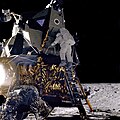 | |
 | |
| 空间站信息 | |
|---|---|
| 成员数量 | 最多4人(计划) |
| 发射日期 | 2027年(计划) |
| 发射载具 | 獵鷹重型运载火箭 SLS Block 1B运载火箭 |
| 发射台 | 肯尼迪航天中心39号发射台
|
| 任务状态 | 研制中 |
| 加压体积 | ≥125 m3(4,400 cu ft) (计划) |
| 远地点 | 70,000 km(43,000 mi) |
| 近地点 | 3,000 km(1,900 mi) |
| 轨道倾角 | 极地近直线晕轨道 (NRHO) |
| 轨道周期 | ≈7天 |
| 配置图 | |
 截至2022年11月16日的舱段配置图 | |
月球门户(英語:Lunar Gateway)空间站,简称门户空间站,是计划於2020年代在月球近直线晕轨道上組裝的太空站。作为阿耳忒弥斯计划的一部分,门户空间站旨在充当宇航员的通讯中心、科学实验室和居住舱。与國際太空站类似,月球门户是一个多国合作项目:参与者包括美国国家航空航天局(NASA)、欧洲航天局(ESA)、日本宇宙航空研究开发机构(JAXA)、加拿大航天局(CSA)和阿联酋穆罕默德·本·拉希德航天中心(MBRSC)。门户计划将成为首个位于低地球轨道以外的空间站。[1][2]
预计将在门户空间站上研究的科学学科包括行星科学、天体物理学、地球观测、太阳物理学、基础空间生物学以及人类健康和表现。[3]截至2024年4月,门户空间站最初的居住和推进模块的建设正在进行中。[4][5][6]由包括美国国家航空航天局在内的14个太空机构组成的国际空间探索协调小组(ISECG)认为,在将人类活动扩展到月球、火星以及太阳系更深处的过程中,门户空间站系统将是至关重要的。[7]
门户空间站预计将在2024年后在阿耳忒弥斯计划中发挥重要作用。美国宇航局2025财年预算中为该项目拨款8.177亿美元。[8]虽然该项目由美国宇航局牵头,但门户空间站与加拿大航天局、欧洲航天局、日本宇宙航空研究开发机构和商业伙伴合作开发、维护和使用。它将作为无人和载人探索月球南极的中转站,也是美国宇航局前往火星的“深空运输”概念中建议的中转节点。[9][10][11]


名称
该空间站原名为深空门户(Deep Space Gateway,简称DSG),在美国宇航局2018年提交的2019年美国联邦预算提案中更名为月球轨道平台门户(Lunar Orbital Platform-Gateway,简称LOP-G)。[12][13]2019年2月15日,NASA预算签署成为法律时,[14]国会已承诺拨款4.5亿美元用于初步研究。[14][15]
2019年11月,美国宇航局公布了空间站现在的名称和标志,标志灵感来自美国边境的象征圣路易斯大拱门。[16]
历史
深太空门户太空站初是NASA已取消的小行星重定向任务的一部分[17]。2017年9月27日,美俄太空當局发表了关于双方合作的非正式联合声明。[18][19]地月间飞行获得的信息和经验有助于未来月球轨道范围以外进行的深太空探索。深太空门户初期将运行在月球附近的晕轨道(NRHO)[20]。计划开始实施后,太空站的各个组件将由太空发射系统以猎户座飞船有效载荷的形式在任务EM-2至EM-8发射。据俄罗斯航天局称,他们也可能使用质子-M和安加拉-A5M重型火箭发射有效载荷或人员。
太空站的能源与推进系统(英語:Power and Propulsion Element,简称PPE)质量8至9吨,利用太阳能发电提供50千瓦[21]的电力为离子推进器供电。离子推进器也可由化学推进器辅助[22]。
研究
美国太空總署于2017年11月1日委托了5项为期四个月的研究来借助私人公司之力寻找开发能源与推进系统的经济方法,这些研究的预算合计240万美元。波音、洛克希德·马丁公司、轨道科学公司、内华达山脉公司和Space Systems / Loral公司承担了该研究[23]。这是继2016年下一代空间技术探索伙伴关系第二阶段(英語:Next Space Technologies for Exploration Partnerships-2,简称NextSTEP-2)商业公司研制居住模块之后的又一次计划。这样的方式可以用于深太空门户,也可以用其他商业项目,所以深太空门户可能也会在NextSTEP方式下开发其他组件[24]。
组件




为了支持计划于2028年进行的首次载人空间站任务(阿提米絲4號),门户空间站将以仅由两个模块组成的最小空间站开始:能源与推进模块(PPE)以及居住与后勤模块(HALO)。PPE和HALO都将在地球上组装,并于2027年一起搭载猎鹰重型火箭发射升空。[25][26]预计它们将在9到10个月后到达月球轨道。[27]I-Hab模块由ESA和JAXA共同研发,将作为阿耳忒弥斯4号载人猎户座任务的联合有效载荷,搭载在SLS Block1B上发射。[28]所有模块将采用国际对接系统标准对接。[29]
计划模块
- 能源与推进模块(英語:Power and Propulsion Element, PPE)用于为空间站和离子推进器发电,与HALO模块一同发射。
- 居住与后勤模块(英語:Habitation and Logistics Outpost, HALO)为空间站提供长期居住的条件,提供一个猎户座飞船的对接口,与PPE一同在2027年由猎鹰重型发射。
- 欧洲燃料补给、基础设施与通信服务系统模块(英語:European System Providing Refueling, Infrastructure and Telecommunications, ESPRIT)为空间站提供燃料、通信和一个货运飞船对接口。其第一部分Lunar Link随HALO一同发射,第二部分Lunar View将于2029年阿提米絲5號任务发射。
- 月球国际居住模块(英語:Lunar International Habitation, Lunar I-HAB)是一个附加居住舱,将于2028年阿提米絲4號任务发射。
- 加拿大臂3(英語:Canadarm3)是一对机器人遥控机械臂,一大一小,与航天飞机加拿大臂和国际空间站加拿大臂2大致相似。
- 乘员科学气闸舱(英語:Crew and Science Airlock Module)用于支持舱外活动,并为深空运输航天器提供对接口,将于2031年由阿耳忒弥斯6号任务发射。
参见
参考文献
- ^ FY 2022: NASA Budget Request (PDF). NASA. 28 May 2021 [1 June 2021].
- ^ Jackson, Shanessa. Competition Seeks University Concepts for Gateway and Deep Space Exploration Capabilities. nasa.gov. NASA. 11 September 2018 [19 September 2018]. (原始内容存档于17 June 2019).
- ^ Mahoney, Erin. NASA Seeks Ideas for Scientific Activities Near the Moon. nasa.gov. NASA. 24 August 2018 [19 September 2018]. (原始内容存档于9 June 2019).
- ^ Hambleton, Kathryn. Deep Space Gateway to Open OpportunitiesArtemis for Distant Destinations. nasa.gov. NASA. 28 March 2017 [April 5, 2017]. (原始内容存档于27 September 2017).
- ^ РОСКОСМОС – NASA СОВМЕСТНЫЕ ИССЛЕДОВАНИЯ ДАЛЬНЕГО КОСМОСА (ROSCOSMOS – NASA JOINT RESEARCH OF FAR COSMOS). [September 29, 2017]. (原始内容存档于10 September 2019) (俄语).
- ^ Weitering, Hanneke. NASA and Russia Partner Up for Crewed Deep-Space Missions. Space.com. 27 September 2017 [5 November 2017]. (原始内容存档于10 September 2019).
- ^ NASA. Gateway Memorandum for the Record (PDF). nasa.gov. NASA. 2 May 2018 [19 September 2018]. (原始内容存档 (PDF)于25 July 2019).
- ^ FY 2025 Budget Estimates (PDF).
- ^ Gebhardt, Chris. NASA finally sets goals, missions for SLS – eyes multi-step plan to Mars. nasaspaceflight.com. NASASpaceflight. 6 April 2017 [19 September 2018]. (原始内容存档于21 August 2017).
- ^ Hambleton, Kathryn. Deep Space Gateway to Open OpportunitiesArtemis for Distant Destinations. nasa.gov. NASA. 28 March 2017 [April 5, 2017]. (原始内容存档于27 September 2017).
- ^ Gatens, Robyn; Crusan, Jason. Cislunar Habitation and Environmental Control and Life Support System (PDF). nasa.gov. NASA. [March 31, 2017].
- ^ Davis, Jason. Some snark (and details!) about NASA's proposed lunar space station. The Planetary Society. February 26, 2018 [February 26, 2018]. (原始内容存档于February 26, 2018).
- ^ Yuhas, Alan. Trump's Nasa budget: flying 'Jetson cars' and a return to the Moon. The Guardian. 2018-02-12 [2018-02-25]. (原始内容存档于18 July 2019). 参数
|newspaper=与模板{{cite web}}不匹配(建议改用{{cite news}}或|website=) (帮助) - ^ 14.0 14.1 Foust, Jeff. Final fiscal year 2019 budget bill secures $21.5 billion for NASA. Space News. February 17, 2019 [April 8, 2023].
- ^ NASA just got its best budget in a decade. planetary.org. [27 February 2019]. (原始内容存档于16 February 2019).
- ^ Pearlman, Robert Z. NASA Reveals New Gateway Logo for Artemis Lunar Orbit Way Station. space.com. September 18, 2019 [28 June 2020]. (原始内容存档于28 June 2020).
- ^ NASA Seeks Information on Developing Deep Space Gateway Module (页面存档备份,存于互联网档案馆). Jeff Foust, Space. 29 July 2017.
- ^ "РОСКОСМОС - NASA. СОВМЕСТНЫЕ ИССЛЕДОВАНИЯ ДАЛЬНЕГО КОСМОСА (ROSCOSMOS - NASA. JOINT RESEARCH OF FAR COSMOS)". [2017-09-29]. (原始内容存档于2019-09-10).
- ^ Weitering, Hanneke. NASA and Russia Partner Up for Crewed Deep-Space Missions. Space.com. 2017-09-27 [2017-11-05]. (原始内容存档于2019-09-10).
- ^ Godwin, Curt. NASA's human spaceflight plans come into focus with announcement of Deep Space Gateway. Spaceflight Insider. 2017-04-01 [2017-04-02]. (原始内容存档于2017-07-31).
- ^ NASA issues study contracts for Deep Space Gateway element. Jeff Foust, Space News. 3 November 2017.
- ^ Chris Gebhardt. NASA finally sets goals, missions for SLS – eyes multi-step plan to Mars. [2017-04-09]. (原始内容存档于2017-08-21).
- ^ Jimi Russell. NASA Selects Studies for Gateway Power and Propulsion Element. [2017-11-02]. (原始内容存档于2018-01-12).
- ^ Erin Mahoney. NextSTEP Partners Develop Ground Prototypes to Expand our Knowledge of Deep Space Habitats. NASA. [2017-11-06]. (原始内容存档于2017-04-10).
- ^ "Artemis Programs: NASA Should Document and Communicate Plans to Address Gateway's Mass Risk". GAO. 31 July 2024. Retrieved 31 July 2024.
- ^ NASA, Gateway Overview. NASA. 3 May 2024 [8 May 2024].
- ^ Foust, Jeff. NASA refines plans for launching Gateway and other Artemis elements. spacenews.com. SpaceNews. 14 May 2020 [18 May 2020]. (原始内容存档于16 May 2020).
- ^ NASA FY 2022 Budget Estimates (PDF): PDF page 97, in-text page DEXP-67.
Delivery of I-Hab to the Gateway will be via the SLS Block 1B launch vehicle with Orion providing orbital insertion and docking.
- ^ Patel, Neel V. NASA Unveils Deep Space Gateway and Transport Architectures. Inverse. 2017-04-04 [2024-05-08] (英语).
外部链接
- Deep Space Gateway to Open Opportunities for Distant Destinations(页面存档备份,存于互联网档案馆)- NASA Journey to Mars
- First human outpost near the Moon(页面存档备份,存于互联网档案馆)-RussianSpace Webpage about the Deep Space Gateway













